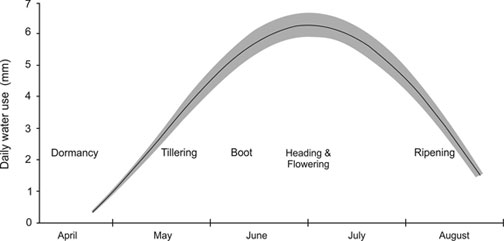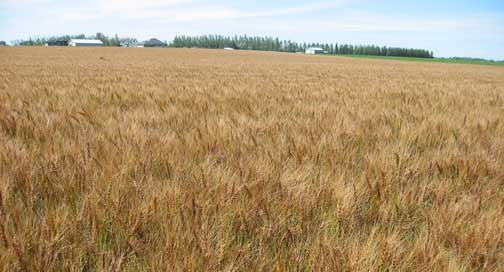| | Irrigation management | Strategies | Winter wheat water needs | Irrigation scheduling strategy | Fusarium Head Blight | Final irrigation | Soil texture
Irrigation management is about controlling the rate, amount, and timing of applied irrigation water in a planned and efficient manner. With good irrigation management, a winter wheat crop can have high yield
and quality potential.
Irrigation Management
The goal of irrigation management is to use available irrigation water effectively in managing and controlling the soil moisture environment of crops to do three things: promote the desired crop response, minimize soil degradation, and protect water quality.
Proper irrigation management requires a good understanding of a number of factors:
- soil fertility (crop nutritional requirements)
- soil-water-plant relationships
- crop type
- crop sensitivity to water stress
- crop growth stages
- availability of a water supply
- climatic factors that affect crop water use such as rainfall, temperature, humidity, and net radiation
- irrigation system capabilities and limitations
Equipped with such knowledge, an irrigator can develop a workable and efficient irrigation scheduling program.
Strategies
A workable and efficient irrigation management strategy should be crop-specific. Crop-specific irrigation management strategies mean available water is used efficiently to meet a specific crop’s water requirements for maximum water productivity.
Generally, the goal is to ensure that water is available at germination and in early development by applying light, frequent irrigations (if there is no rainfall). This method promotes vigorous growth and replenishes and increases available soil water content in the entire root zone during the pre-flowering growth stages. Such a strategy will allow modern sprinkler irrigation systems to keep up to crop demand during the peak water use period, which typically occurs during the flowering and fruit-formation growth stages.
Crop-specific irrigation management strategies are usually applied to adjust for the following differences among crops:
- effective root zones
- sensitivity to water stress
- types (cool versus warm-season)
- vulnerability to diseases at various crop growth stages
- response to soil fertility levels
- plant population/densities
- physiologic maturity (timing of last irrigation)
- potential income
Winter Wheat Water Needs
Winter wheat uses water for growth and cooling purposes. The water requirement or evapotranspiration (ET) for winter wheat depends on variety, growth stage, canopy density, climatic conditions, and irrigation and crop management.
Winter wheat grown under optimal conditions (well-fertilized, well-irrigated, seeded in standing stubble, pest-free, and uniform and optimum canopy) requires 400 to 430 mm of water per growing season in southern Alberta. When seeded into soil with available water between 60 and 100 per cent in mid-September, winter wheat will germinate, grow rapidly, and reach a peak water use of between 1.5 to 2 mm per day in October prior to freeze-up or the dormancy growth stage. Winter wheat usually comes out of dormancy at the tillering growth stage in April of the following spring.
Average winter wheat water use ranges from 0.1 mm per day soon after coming out of dormancy to nearly 7 mm per day during the flowering and fruit-formation growth stages (Figure 1).
Typically, the roots of winter wheat grow to an effective water extraction depth of 100 cm in a well-developed soil. Root distribution is concentrated near the surface; hence, winter wheat obtains more than 70 per cent of its seasonal water from the upper 50 cm of the active root zone. The active root zone changes from a few millimetres at emergence to a maximum depth of 100 cm at the flowering growth stage.
Effective winter wheat irrigation scheduling uses soil water levels in the root zone as a measure for starting and stopping irrigations. Adequate soil water is critical for winter wheat during emergence, vegetative (pre-flowering), flowering, and fruit-formation growth stages.

Figure 1. Daily water use during different growth stages of irrigated winter wheat in southern Alberta. Shaded area indicates the variations in winter wheat water use depending on plant type, cultivar, and climatic conditions.
Irrigation Scheduling Strategy
It is best to have a seedbed soil profile (0 to 30-cm depth) that is near 80 per cent of field capacity at planting (field capacity is the maximum amount of water a soil can hold, provided the soil drains freely).
Winter wheat needs to have water for germination and root development during the early stages of growth. If the seedbed is dry (less than 60 per cent of available), a light irrigation of 15 mm should be applied prior to seeding. Inadequate soil water in these early growth stages results in reduced plant populations, which, in turn, reduce final grain yield. To ensure soil water is adequate for germination, irrigation should be applied prior to seeding to minimize emergence problems associated with soil crusting.
In southern Alberta, winter wheat is usually seeded in the middle of September, reaches full emergence at the end of September, and reaches the three-leaf or early tiller stages in October prior to freeze-up. The crop comes from dormancy in April when it is tillering, reaches canopy closure in May, heads out in June, flowers from late June to early July, and reaches physiologic maturity in August (Figure 1).
If well-fertilized, a pest-free winter wheat stand will reach maximum grain yield and quality if ample water is available in the root zone during the tillering and flowering growth stages. To ensure that ample water is available to winter wheat during the vegetative growth stages (i.e. tillering to late boot), available soil water should not be depleted to less than 50 per cent in the upper 50 cm of the 100-cm root zone. Any irrigation applied during the vegetative growth stages should start when the available soil water is near 60 per cent of available to prevent the available soil water from being depleted to less than 50 per cent.
Maintaining available soil water above 50 per cent in the upper 50-cm depth during the vegetative growth stages translates to light and frequent irrigation applications. Irrigation water applied during the vegetative growth stages should meet crop water requirements and build up soil water to near field capacity in the 50 to 100-cm zone for later crop use during the peak water use period when flowering is occurring.
In general, winter wheat is most sensitive to inadequate soil water during the flowering growth stage. Inadequate soil water during this stage results in flower abortion.
Winter wheat roots reach maximum extension at the flowering growth stage. To ensure that soil water is adequate throughout the root zone during flowering, the monitoring depth of the root zone should be increased from 50 cm to 100 cm at the early heading growth stage, and soil water should not be depleted to less than 60 per cent of available (i.e. allowable depletion should not be greater than 40 per cent of available).
Irrigations should be scheduled to fill the entire root zone (100 cm) to field capacity at the beginning of the late boot-early heading growth stages to avoid applying irrigations during the flowering growth stage when the crop is most vulnerable to Fusarium Head Blight (FHB).
Increasing the irrigation management root zone from 50 cm to 100 cm at the late boot-early heading growth stages requires less frequent and larger irrigation volumes and results in increased water availability to the mature winter wheat roots. This increased time between irrigations keeps the canopy dry, discouraging the growth of FHB.
Fusarium Head Blight
The strategy of scheduling irrigations to fill the entire root zone (100 cm) to field capacity at the beginning of the late boot-early heading growth stages, combined with the application of appropriate fungicides, may help reduce the severity of Fusarium Head Blight (FHB) infection. The risk of FHB increases when the canopy is moist due to rainfall or irrigation during flowering.
Applying irrigation to recharge the 100-cm root zone to field capacity at the start of heading should be done whether or not the allowable depletion soil water content (irrigation trigger) has been reached. The next irrigation event should be applied after flowering is complete (about 10 days after the first flower appearance) and when soil water content is near 60 per cent of available in the 100-cm root zone (Table 1).
As an additional management tool for managing the risk of FHB, it is recommended that winter wheat growers consider increasing seeding rates, which helps reduce tiller formation and shorten the flowering period for the entire crop, thus reducing the time that irrigation should be avoided.
Final Irrigation
The timing of the last irrigation to refill the root zone for winter wheat depends largely on soil texture. The final irrigation may be applied at the soft dough growth stage when winter wheat is grown in most soils except for loamy sand soils, which are limited by the lower water-holding capacity. The last irrigation to refill the root zone may be needed between the soft dough and hard dough stages on loamy sand soils.
About 80 mm of water is required to carry winter wheat from soft dough to physiologic maturity in southern Alberta. No irrigation water is needed once the heads have completely turned colour from green to brown since the crop is mature at this point and yields have been established (Figure 2).

Figure 2. A well-irrigated winter wheat crop (variety: Radiant) near Lethbridge, Alberta, on August 18, 2009
(96 bu/ac).
Soil Texture
The irrigation amounts required to replenish the root zone once the allowable depletion soil water level is reached will vary with soil texture and growth stage (Table 1).
Table 1. Soil texture-based estimation of total available water and water amounts per irrigation event for winter wheat during the winter wheat growing season
Soil texture | 50-cm root zone
(Vegetative or pre-flower growth stages) | 100-cm root zone
(Flowering, fruit formation, and
maturation growth stages) |
 | Total available water (mm) | Water required to replenish soil to field capacity at 50% allowable depletion (mm) | Total available water (mm) | Water required to replenish soil to field capacity at 40% allowable depletion (mm) |
| Loamy sand | 57 | 28 | 114 | 46 |
| Sandy loam | 70 | 35 | 140 | 56 |
| Loam | 90 | 45 | 180 | 72 |
| Sandy clay loam | 76 | 38 | 152 | 61 |
| Silt loam | 100 | 50 | 200 | 80 |
| Clay loam | 100 | 50 | 200 | 80 |
| Silty clay loam | 110 | 55 | 220 | 88 |
| Sandy clay | 86 | 43 | 172 | 69 |
| Silty clay | 106 | 53 | 212 | 85 |
| Clay | 96 | 48 | 192 | 77 |
Conclusion
Using suitable irrigation strategies with winter wheat can mean a healthy crop with high yield and quality potential. In addition to ensuring that the winter wheat crop is well-fertilized and well-protected from pests, growers are encouraged to properly manage irrigation by regularly monitoring soil water to ensure that the availability of water does not become a limiting factor in producing a high-yielding winter wheat crop.
Applying irrigation just before the available soil water is depleted to 50 per cent during the pre-flowering growth stage and 60 per cent between early heading and physiologic maturity as well as replenishing available soil water near field capacity in the appropriate root zones will greatly assist in producing a high quality and high-yielding winter wheat crop.
Prepared by
Alberta Agriculture and Forestry
For more information, contact
Alberta Ag-Info Centre
Call toll-free 310-FARM (3276)
Source: Agdex 112/561-1. February 2011. |
|